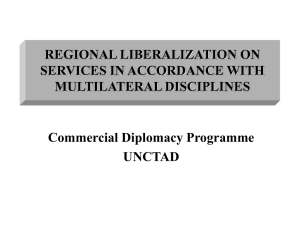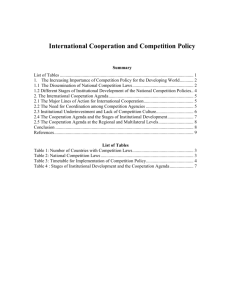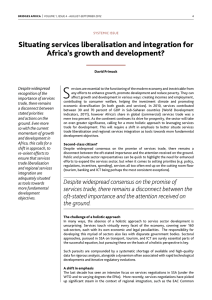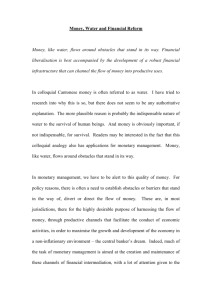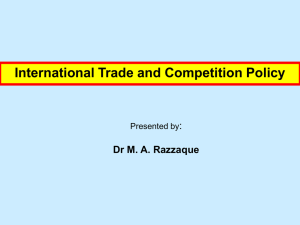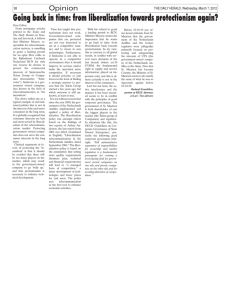Trade and comeptition Trudi Hartzenberg
advertisement
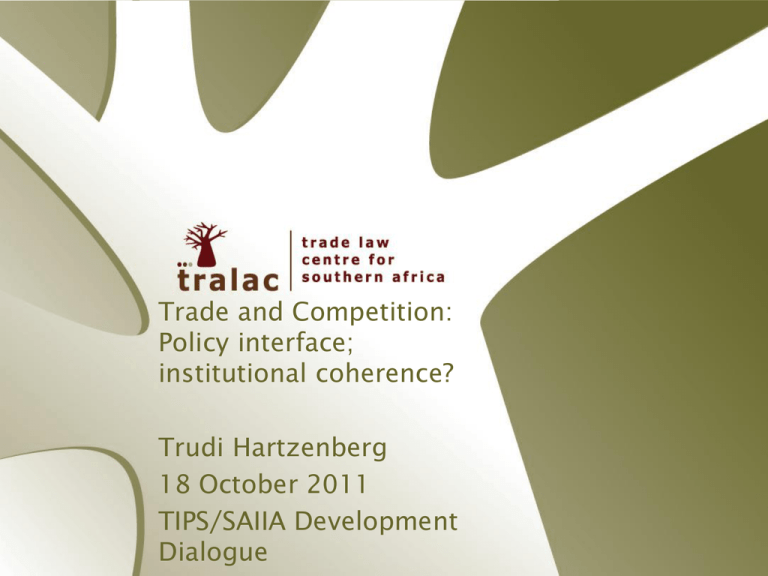
Trade and Competition: Policy interface; institutional coherence? Trudi Hartzenberg 18 October 2011 TIPS/SAIIA Development Dialogue Overview • Background – scope of trade and competition policy • South Africa’s trade and competition policy development • Competition issues in regional trade agreements • Competition policy and SA’s trade relations • Trade-investment-competition nexus – cases • Conclusions Background – Definitions and Scope • Competition policy: central focus – efficiency: measures to promote competition (safeguard competition not competitors), prevent anticompetitive practices and regulate mergers (can impact competition and market structure) Key issues: - Units of analysis: firm and the market (‘relevant market’) - Scope of competition policy (national, regional…no multilateral agreement); usually ‘all econ activity’ will be covered • Trade liberalisation (multilateral, regional, unilateral) reduces barriers between nation states – facilitating market integration (dominant paradigm is perhaps still focused on trade in goods – border measures: tariff) Key issues: - impact on market definition (mkts & competition transcend national borders); - beyond trade in goods (services, investment lead logically to Scope, Definitions • Focus on competition policy-trade policy interface: - No multilateral agreement on competition, but early recognition of trade-competition interface: Havana Charter (Ch V – provision on restrictive business practices) - As govt barriers decline, private barriers may increase… - Globalisation (trade and investment integration; increase in transborder activities increased scope for cartels, vertical restraints) – given governance gaps - Trade, investment, competition connections in GATS, TRIMS, TRIPS - In short: some concerns that benefits of trade liberalisation may be reduced by anti-competitive practices Trade and competition policy development in South Africa (1) • Early Post-1994: period of extensive policy reform i) Trade: from import-substitution to export orientation - enthusiastic liberalisation immediate post-1994 period; slow down towards late 1990’s… trade policy serves industrial policy objectives (import tariff – instrument of industrial policy to be used selectively to protect specific industries); 2009 Trade Policy: strategic tariff policy Institutional architecture: dti, and since 2009 DED (oversight function: International Trade Administration Commission) Trade and competition policy development (2) ii) Competition policy: long history in SA; development of robust competition policy (post-’94) was only possible if public interest imperatives were accommodated; hallmark of SA’s competition policy – explicit articulation of public interest objectives (eg in merger review i) impact on a particular industrial sector or region, ii) employment, iii) ability of small and historically disadvantaged persons to compete, iv) international competitiveness of national industries) Institutional architecture: Competition Commission, Competition Tribunal, Competition Appeal Court – oversight shifted from dti to DED Brief history: Competition Act 89 of 1998 (as amended) - strong focus on merger control initially, more recently restrictive practices cases (eg cartels); procedural/administrative justice issues – eg participation of trade unions - not party to any international agreements which provide eg for crossborder merger control Implications of this institutional reconfiguration? Capacity and more Competition in multilateral agreements No multilateral agreement on competition, but: • Recognition of relationship between trade and competition policy (debate: complements or is a liberal trade policy a substitute for competition policy?) • Havana Charter - chapter V • GATS, Article VIII: Members to ensure that state monopolies do not act in a manner inconsistent with their obligations/specific commitments • TRIPS, Articles 8 and 40: Authority to take measures against abuses of intellectual property rights/ anti-competitive licensing practices • Basic Telecom Negotiations, Reference Paper on Regulatory Principles: Commitment to adopt appropriate measures to prevent anti-competitive practices by major suppliers Competition in multilateral trade agreements • Agreement on Safeguards, Article 11:3: Members not to encourage/support the adoption of non-governmental measures equivalent to voluntary export restraints, orderly marketing arrangements or other governmental arrangements prohibited under Article 11.1 • Consultation Arrangements, 1960 Resolution under GATT and GATS: Recognition that business practices that restrict competition in international trade may hamper the expansion of world trade and economic development Competition provisions in RTAs • The inclusion of competition policy in RTAs is part of a trend towards deeper integration: inclusion of new generation trade issues (services, investment, competition policy….labour, environment) • Competition provisions vary from: best endeavour (we’ll try to cooperate), legally binding cooperation, supra-national institutions, limitations to trade remedies • South Africa’s strategic trade policy: - strong focus on trade in goods (linked to industrial policy paradigm)strategic tariff policy (selective tariff review process by Itac) - no impetus to include new generation issues - partnerships: South-South relationships - an emerging African strategy? Competition and South Africa’s trade relations • Southern African Customs Union (SACU): Part 8 – Common Policy Development, art 40 (each member state must have a competition policy and member states agree to cooperate in enforcement) – no mention of institutional model. • Southern African Development Community (SADC): SADC Declaration on Regional Cooperation in Competition and Consumer Policies (adopted 2008, signed 2009) – cooperation (formalise) in enforcement, and in merger control Important question: relationship between competition policy and trade remedies (anti-dumping, countervailing to counter unfair trade practices) - with deeper integration competition policy increases in importance • Cooperation with other agencies: European Commission, US Federal Trade Commission and others (eg in Africa; African Competition Forum) Trade-investment-competition nexus Recent case: Walmart: Massmart merger – what are the issues: - acquisition of 51% stake in Massmart by Walmart - trade in services (GATS commitments – distribution sector fully liberalised across all four modes of supply): Mode 3 (supply of a service by a services supplier of one Member, through commercial presence in the territory of another Member) ie investment (FDI) - key issues raised, include: sourcing strategy, employment Large merger review process: unconditional approval by Commission, conditional approval by Tribunal (conditions suggested by parties), now appeal by govt depts (dti, DED, DoA) Note: cannot invoke national laws to escape international law obligations Some concluding remarks Clear links between trade (and investment) and competition policy (regional integration, global integration) – markets transcend national borders; this creates governance gaps (scope of trade law, trade remedies) Therefore: • Impact of trade liberalisation may be circumscribed by anticompetitive practices • • South Africa’s competition policy: robust market governance instrument (limited extra-territorial application), strong institutional architecture (independent) • South Africa’s trade policy: rethink from enthusiastic embrace of liberalisation to more circumspect approach based on specific industrial policy objectives (keep in mind that the New Growth Path is essentially an industrial strategy) – supporting the overall objective of job creation (political imperative) South Africa’s trade relations: focused liberalisation (goods), S-S partnerships (consistent with more inward policy focus) •

